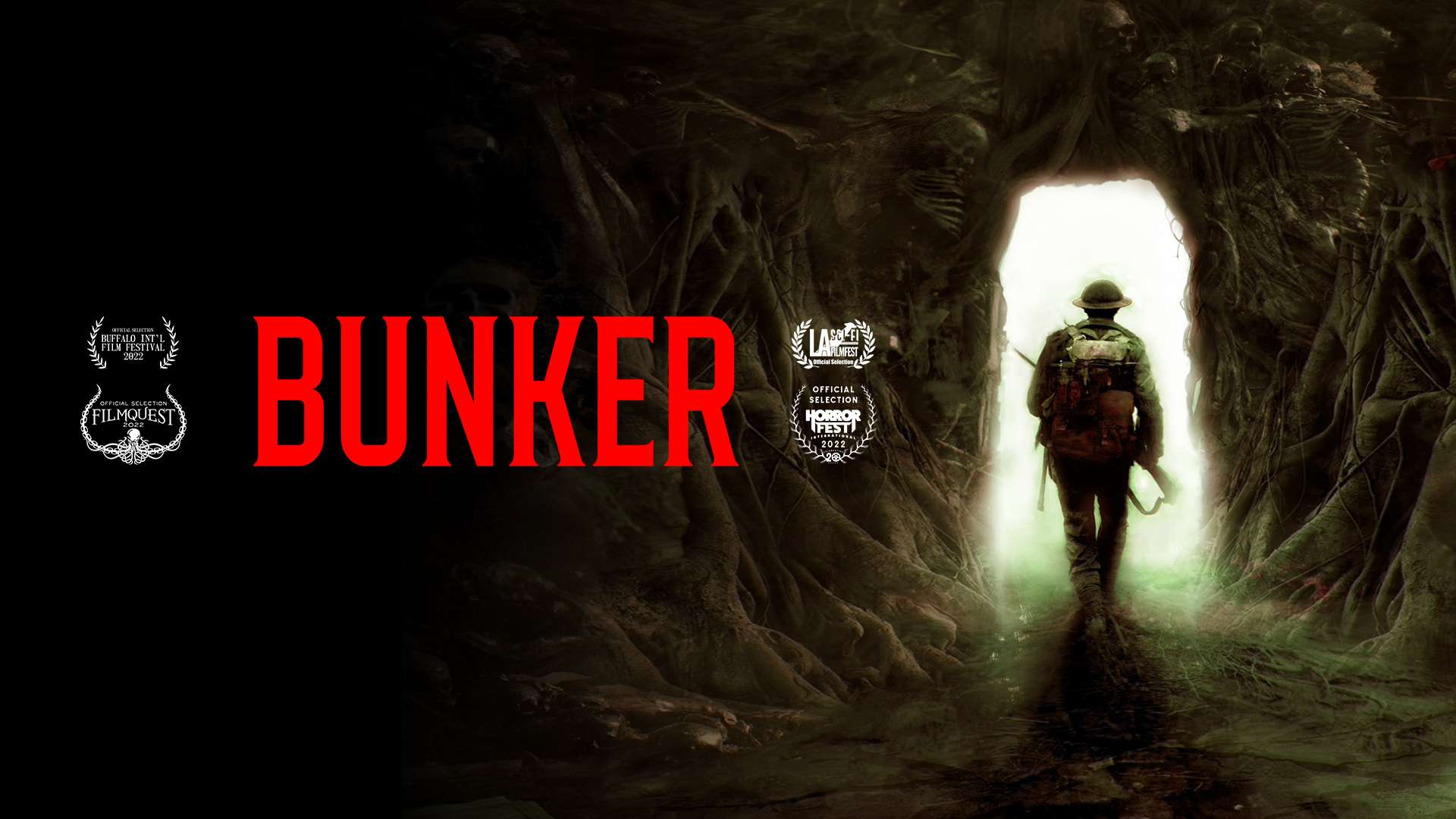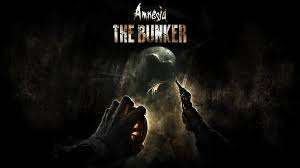BUNKER (2023), directed by Adrian Langley, is a gritty psychological horror set against the grim backdrop of World War I. At first glance, it appears to be a war film—but it quickly reveals itself to be something far more unsettling: a paranoid, slow-burning descent into fear, madness, and the monstrous instincts that emerge when humans are pushed beyond their breaking point. Melding war drama with supernatural horror, BUNKER stands out as a compact, tension-filled tale that explores the fragility of the human mind and the corrosive effects of isolation, distrust, and trauma.
Plot Summary
The story unfolds in 1918, as a group of American and British soldiers are pinned down in a trench during an artillery bombardment. Seeking shelter, they descend into a buried German bunker discovered beneath the battlefield. What initially seems like a temporary refuge quickly turns into a nightmare. The deeper they go, the more it becomes clear that something is wrong—not just with the bunker itself, but with the soldiers inside it.
Cut off from the outside world and increasingly paranoid, the group begins to unravel. A mysterious German prisoner is found lurking in the shadows. Strange symbols are scrawled on the walls. Equipment begins to malfunction. Tensions flare. What follows is a tense psychological unraveling as the soldiers confront not only the horrors of war but something far older, darker, and more malevolent lurking beneath the surface.

Tone and Atmosphere
One of BUNKER’s strongest elements is its oppressive, claustrophobic atmosphere. The entire film takes place in cramped, dimly lit spaces: muddy trenches, suffocating tunnels, and narrow underground passageways that seem to close in more and more as the story progresses. Langley’s direction makes you feel trapped alongside the characters. You can practically smell the damp earth and sweat, hear the distant booms of artillery echoing above, and feel the weight of isolation pressing in.
The lighting is intentionally sparse—mostly from lanterns and flickering torches—casting long shadows that enhance the mounting dread. This visual restraint serves the film well; rather than rely on jump scares or over-the-top gore, BUNKER focuses on slow-building paranoia, emotional disintegration, and the terrifying question of what’s real and what’s imagined.
Themes: Fear, Paranoia, and the Enemy Within

While the supernatural elements of BUNKER are kept deliberately vague, the film leans heavily into psychological horror. Its true subject isn’t monsters or ghosts—it’s fear itself. The soldiers begin to turn on one another, accusing, doubting, hallucinating. Trust erodes. Brotherhood dissolves. The film becomes a study in how fear of the unknown—and fear of each other—can be more deadly than any external enemy.
There are echoes of The Thing (1982) and even Heart of Darkness in the way BUNKER handles its descent into madness. The German prisoner, with his cryptic behavior and unsettling calm, serves as a kind of mirror—forcing the Allied soldiers to confront their own hypocrisies and darkness. Is the enemy truly the man across the line, or the man standing next to you?
The film also hints at an ancient evil, perhaps something Lovecraftian or demonic, buried within the bunker itself. But this element is never fully explained—and that ambiguity works in the film’s favor. Whether it’s literal or a projection of war-born insanity is left up to the viewer, deepening the psychological complexity.
Characters and Performances

The ensemble cast delivers strong, committed performances, despite a relatively sparse script. Eddie Ramos, as Pvt. Baker, gives a standout performance, portraying a young soldier slowly coming unglued by the stress of command, the fog of war, and a growing sense of doom. His character arc is compelling—he begins as a rational leader, trying to maintain discipline, but ends up haunted and hopelessly fractured.
Luke Baines plays Lt. Turner, a more experienced British officer whose stern discipline masks deep emotional damage. His clashes with Baker and the rest of the crew—particularly over how to handle the German prisoner—form much of the dramatic tension in the middle of the film.
Patrick Moltane as the unsettling German prisoner delivers one of the most memorable performances in the film. With few lines, he evokes an eerie, almost supernatural presence. Whether he’s a man driven mad by his own experiences or something far darker is one of the film’s central mysteries.
Other characters, like the religious soldier who quotes scripture in the face of the unknown, or the medic who tries to reason with everyone, represent various coping mechanisms for horror—faith, logic, aggression, and denial. While some characters feel slightly archetypal, they work effectively within the confined narrative space.
Direction and Technical Execution
Adrian Langley’s direction is focused and assured. He keeps the action contained, the dialogue terse, and the pacing deliberate. It’s a film that rewards patience—slowly building dread rather than providing quick payoffs. While this might frustrate viewers expecting a more traditional horror narrative or action-heavy war film, those who appreciate psychological horror will find BUNKER deeply atmospheric and rewarding.
The sound design deserves special mention. The creaking of wooden beams, distant rumblings, water dripping from ceilings, and intermittent gunfire all contribute to an immersive soundscape that underscores the constant danger and isolation.
The makeup and practical effects are minimal but effective. When violence does erupt, it is raw and shocking—used sparingly but powerfully. There’s a sense of restraint in how the horror is presented, allowing the tension and unease to do most of the work.
Criticism and Weaknesses
While BUNKER is a compelling film, it’s not without its flaws. The pacing, especially in the middle act, can feel sluggish. There are stretches where the characters repeat the same arguments or wander through tunnels without much narrative momentum. Some viewers may find the film’s ambiguity frustrating, particularly the lack of explanation surrounding the bunker’s supernatural aspects.
Additionally, the film’s dialogue occasionally lapses into cliché, and not all character arcs are fully fleshed out. Given the tight runtime and small cast, a bit more development could have helped some emotional beats land harder.
Conclusion
BUNKER (2023) is a slow-burn psychological horror film that skillfully uses its confined setting and wartime backdrop to explore deeper themes of fear, distrust, and the breakdown of the human psyche. It isn’t a movie for fans of jump scares or straightforward narratives. Rather, it’s a film that creeps under your skin, leaving you unsettled and reflective long after the credits roll.
In an era where horror often relies on spectacle, BUNKER impresses with its restraint, atmosphere, and commitment to psychological tension. It asks unsettling questions about the nature of evil and whether it comes from without—or from within.
Final Rating: 8/10





